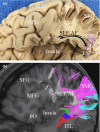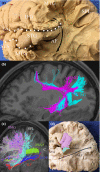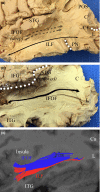White matter connections of the inferior parietal lobule: A study of surgical anatomy
- PMID: 28413699
- PMCID: PMC5390831
- DOI: 10.1002/brb3.640
White matter connections of the inferior parietal lobule: A study of surgical anatomy
Abstract
Introduction: Interest in the function of the inferior parietal lobule (IPL) has resulted in increased understanding of its involvement in visuospatial and cognitive functioning, and its role in semantic networks. A basic understanding of the nuanced white-matter anatomy in this region may be useful in improving outcomes when operating in this region of the brain. We sought to derive the surgical relationship between the IPL and underlying major white-matter bundles by characterizing macroscopic connectivity.
Methods: Data of 10 healthy adult controls from the Human Connectome Project were used for tractography analysis. All IPL connections were mapped in both hemispheres, and distances were recorded between cortical landmarks and major tracts. Ten postmortem dissections were then performed using a modified Klingler technique to serve as ground truth.
Results: We identified three major types of connections of the IPL. (1) Short association fibers connect the supramarginal and angular gyri, and connect both of these gyri to the superior parietal lobule. (2) Fiber bundles from the IPL connect to the frontal lobe by joining the superior longitudinal fasciculus near the termination of the Sylvian fissure. (3) Fiber bundles from the IPL connect to the temporal lobe by joining the middle longitudinal fasciculus just inferior to the margin of the superior temporal sulcus.
Conclusions: We present a summary of the relevant anatomy of the IPL as part of a larger effort to understand the anatomic connections of related networks. This study highlights the principle white-matter pathways and highlights key underlying connections.
Keywords: DTI; anatomy; angular; gyrus; inferior parietal; supramarginal; tractography; white matter.
Figures






Similar articles
-
Anatomy and white-matter connections of the precuneus.Brain Imaging Behav. 2022 Apr;16(2):574-586. doi: 10.1007/s11682-021-00529-1. Epub 2021 Aug 26. Brain Imaging Behav. 2022. PMID: 34448064
-
Decoding the superior parietal lobule connections of the superior longitudinal fasciculus/arcuate fasciculus in the human brain.Neuroscience. 2014 Sep 26;277:577-83. doi: 10.1016/j.neuroscience.2014.07.035. Epub 2014 Jul 30. Neuroscience. 2014. PMID: 25086308
-
Anatomy and White Matter Connections of the Middle Frontal Gyrus.World Neurosurg. 2021 Jun;150:e520-e529. doi: 10.1016/j.wneu.2021.03.045. Epub 2021 Mar 17. World Neurosurg. 2021. PMID: 33744423
-
Anatomical variability of the arcuate fasciculus: a systematical review.Surg Radiol Anat. 2019 Aug;41(8):889-900. doi: 10.1007/s00276-019-02244-5. Epub 2019 Apr 26. Surg Radiol Anat. 2019. PMID: 31028450
-
Microsurgical Anatomy of the Insular Region and Operculoinsular Association Fibers and its Neurosurgical Application.World Neurosurg. 2019 Sep;129:407-420. doi: 10.1016/j.wneu.2019.05.071. Epub 2019 May 25. World Neurosurg. 2019. PMID: 31132493 Review.
Cited by
-
Reading Braille by Touch Recruits Posterior Parietal Cortex.J Cogn Neurosci. 2023 Oct 1;35(10):1593-1616. doi: 10.1162/jocn_a_02041. J Cogn Neurosci. 2023. PMID: 37584592 Free PMC article.
-
Differential intrinsic functional connectivity changes in semantic variant primary progressive aphasia.Neuroimage Clin. 2019;22:101797. doi: 10.1016/j.nicl.2019.101797. Epub 2019 Mar 27. Neuroimage Clin. 2019. PMID: 31146321 Free PMC article.
-
The Unique Fiber Anatomy of Middle Temporal Gyrus Default Mode Connectivity.Oper Neurosurg. 2021 Jun 15;21(1):E8-E14. doi: 10.1093/ons/opab109. Oper Neurosurg. 2021. PMID: 33929019 Free PMC article.
-
Differences in structural MRI and diffusion tensor imaging underlie visuomotor performance declines in older adults with an increased risk for Alzheimer's disease.Front Aging Neurosci. 2023 Jan 12;14:1054516. doi: 10.3389/fnagi.2022.1054516. eCollection 2022. Front Aging Neurosci. 2023. PMID: 36711200 Free PMC article.
-
White matter dissection with the Klingler technique: a literature review.Brain Struct Funct. 2021 Jan;226(1):13-47. doi: 10.1007/s00429-020-02157-9. Epub 2020 Nov 9. Brain Struct Funct. 2021. PMID: 33165658 Free PMC article. Review.
References
-
- Alain, C. , He, Y. , & Grady, C. (2008). The contribution of the inferior parietal lobe to auditory spatial working memory. Journal of Cognitive Neuroscience, 20, 285–295. - PubMed
-
- Averbeck, B. B. , Battaglia‐Mayer, A. , Guglielmo, C. , & Caminiti, R. (2009). Statistical analysis of parieto‐frontal cognitive‐motor networks. Journal of Neurophysiology, 102, 1911–1920. - PubMed
MeSH terms
LinkOut - more resources
Full Text Sources
Other Literature Sources

